The GREAT SEXTOGUIDRUM Dave Thompson |
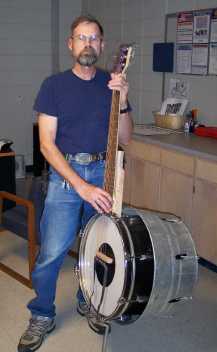 |
| I used a six-string bass guitar neck and a 21-inch bass drum, a No. 3 washtub, four feet of red oak and assorted hardware all in stock at Home Depot, and six genuine bass guitar strings. At $200, it still cost much less than a bass viol and isn't made of varnished wood needing careful handling while being much too large to handle carefully. And, with the end pin (made of two feet of scrap 1/2 inch electrical conduit with a cane tip on the end) retracted, it fits in the back seat of my Chevy Cavalier! |
| FRAME BUCKET Michael Bishop |
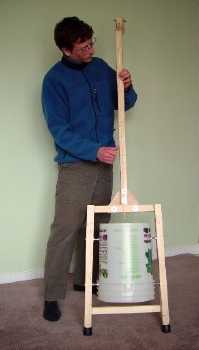 |
| I used a plastic bucket because I couldn't find a real washtub, so the sound is a bit soft and quiet. The unique thing about the design is that I suspended the bucket between two legs so you can tilt it back and forth while you are playing, like a real standup bass. Also, since there are two legs (instead of a single peg in the middle on the bottom crosspiece), you can lean it against a wall or a chair without it falling over. |
| DOBRO BASS Ozarkana Jon |
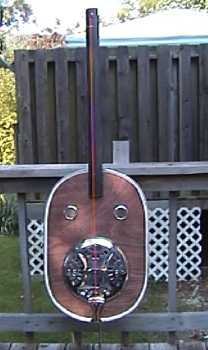 |
| The neck of my Dobro-style resonator bass is formed of two pieces of baseboard molding glued together. There is a natural "pocket" formed in the middle. I chiselled out some more wood so it would slide on to a steel "L" bracket fastened to the end of the tub, making it easy to disassemble for transport. |
| "ERNESTINE" Cap'n James Cook |
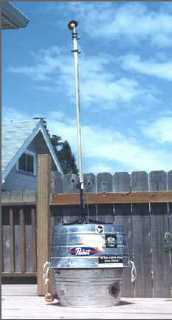 |
| To make the neck, I removed the top half off a $10 guitar stand, leaving an extremely sturdy tripod with a 7/8" opening. I took a 4' X 1" birch dowel and filed the bottom 4" or so, and pounded it into this socket with a mallet. (A small extension on the lower part of the stand is only tack welded on and can be knocked off with the same mallet.) Put 1" rubber furniture feet over the existing rubber feet, and shorten the two longer legs of the stand so the neck stands behind the tub center. Between the tubs is a circle of 1/2" plywood, flush with the bottom of the top tub, with about a 1" space all around to port to the outside air. It's held in place by 2x2 spokes at 12, 3, 6, and 9 o'clock, attached to the tub with sheetrock screws. Then I took a #1 tub and attached it (open end up) to the bottom of the wood disk. I used 1 1/4" deadbolt drill bit to put about eight holes in the plywood so some sound would pass through, and I'm still experimenting with that. |
| The G-TWANG Stephanie Hansen |
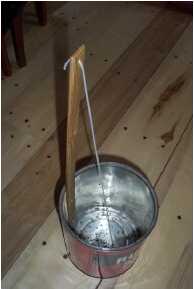 |
| The g-twang is like a miniature washtub bass, made from a one-gallon paint can with a doubled yardsticks bolted to the side and a weedcutter string attached to the end of the yardsticks and bottom of the can. It is played bottle-neck style. |
| THE STUDIVARIOUS Studio Stu |
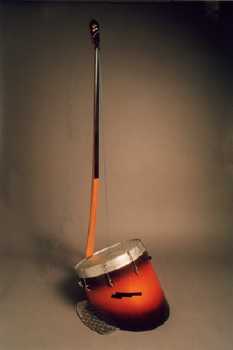 |
| The body of my "Studivarious" is an 18" maple bass drum shell, cut obliquely to give it a 'leanback', with two f holes (and a vintage sunburst finish.) The bottom few inches of a tub are cut off and attached as the head. The neck is curly maple, with an ebony fingerboard and a curved flat bottom that fits into the rim of the tub to hinge without twisting. You stabilize the bass by standing on a retractable plate at the bottom. |
| BUNGEE BASS Chris Dennstaedt |
 |
| The neck of the Bungee Bass, which runs the length of the sculpture, is a cardboard tube used to roll up carpet. The two boxes that make up the body of the bass are offset so as to act as a cutaway to allow the fretting hand greater access to the bridge-most end of the bungee cord. The bungee cord stretches from the top end of the tube, across a cardboard bridge and then into the bottom end of the tube. Like the Mailing Tube Marimba, the bass is modular; the boxes unbolt from the neck and the plunger fiddle spike/stand unscrews from the bottom of the neck. |
| BARROW BASS Rick |
 |
| The wheelbarrow is a TrueTemper 6 cubic ft. contractor model. I use DiAdarrio mandobass strings. The top is 1/4" oak ply. The neck is maple, the fingerboard and tailpiece are bloodwood, and the bridge is cocobolo. It actually has very nice tone and fairly good volume. The tub easily detaches from the handle and wheel assembly and I have a variety of posts for different size players. |
| ROCK 'N FINGER TOO Jim Bunch |
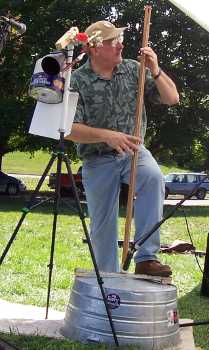 |
| I have built a cross brace for the pole using a board the width of the tub supported by two small blocks that fit on the rim. This allows you to support the pole closer to the center of the tub and get good notes without putting as much tension on the string and your fingers. [Moving the pole changes the string tension and the pitch, but] you can also move up and down the pole to change notes. I tend to both adjust the tension and finger 5ths when I play. I screwed a rubber table leg cover to the middle of the cross brace that the pole fits in. This allows the pole and brace to be disassembled for the trunk of the car. |
| A TRULY UPRIGHT BASS Ol' Dan |
 |
| The upright [neck] is a wheelbarrow handle with an oak fingerboard, rounded at the edges. String is upright bass G-string. A long lag bolt, lot of glue and an L-brace attach the upright to the board spanning the tub's bottom. The board is hooked to the tub's handles with turnbuckles. Tunable, and immensely playable, the thing sounded best, and was easier to play, when resting on top of a 5-gallon bucket with notches cut in its rim in which the rim of the tub sat for stability. I got about an octave and a half out of it. Tuned it mostly to D. |










